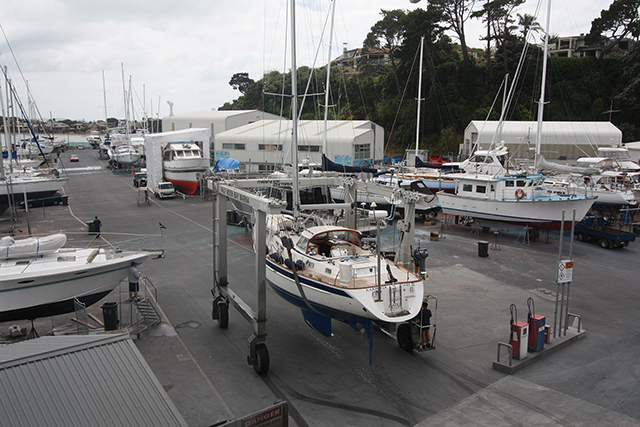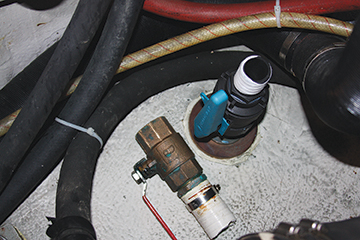A guide to decommissioning and commissioning your boat in a foreign port (published April 2014)
A high percentage of cruisers we meet each year plan on leaving their boats in a safe place and flying home, often once a year. Avoiding cyclone season in the Pacific and hurricane season in the Atlantic are the main reasons sailors choose to leave their boats, but many fly home to visit family or restock the cruising kitty, too. And because international air travel has never been less expensive, many cruisers find they can more than cover the cost of flying home by the money they save in purchasing spare and replacement parts “back home” vs. in the country they’ve sailed to.
If you’re leaving your boat for less than four weeks, it may be most convenient to leave it in the water, providing you can find a secure marina slip or mooring. For longer periods of time, it may be cost effective and attractive to combine dry storage in a secure boat yard with your annual haul out. We’ve left Mahina Tiare 1, II & III on the hard or in the water in New Zealand, Chile, Panama, Sweden, the Azores, Portugal, Hawaii and Canada over the past 35 years and have learned quite a bit about the process, from choosing a place to keep the boat to the actual practice of decommissioning and commissioning when we leave and return to the boat. Here is a comprehensive guide to leaving your boat in a foreign port and returning to sail her again. (The following criteria are optimal, and obviously, in developing countries not all of these features or services will be available.)
DO YOUR HOMEWORK
As with many things in life and cruising, the first place to start when deciding to leave your boat in a foreign port is to do your homework. A good place to begin a preliminary search is to check www.noonsite.com for recommendations and contacts. Also, Seven Seas Cruising Association (ssca.org) often has bulletins and letters detailing member’s experiences with leaving their boats in places around the world. Next, go straight to the source and ask local sailors or other cruisers for their recommendations, and if possible, visit the yards and marinas to talk with the operators.
When looking for a marina to leave your boat, one of the main criteria to meet is for a well-managed and operated front office. The quality of the folks operating the place is going to make you feel a lot better about leaving your boat there for an extended period. Also, check to see if gates for marina piers lock and ask if there are security guards or cameras.
If you choose to leave your boat on the hard in a boatyard, again, look for a well-managed office and also a yard with a paved, fenced and guarded storage compound. Ensure that the displacement of your boat is not close to the limits of the Travelift or cradles, that the lift is well maintained and that the cables and straps are regularly inspected and periodically replaced. If possible, try to leave your boat in a steel cradle with adjustable arms rather than on screw jacks or 55-gallon drums with wedges. Always inquire about the yard’s insurance policy. Does it cover damage to your boat if they drop it, run into it, or if it blows over while in the yard?
If you are leaving the boat for an extended period of time it may work out well to leave a list of jobs to be done with the yard or associated workmen, so inquire about nearby yacht services including sail, engine and rigging repair. They can then work on your boat in a down time, rather than it becoming a rush job upon your return, and they’ll appreciate the business. Contact the yard a month before your return to make sure the jobs are being completed. And lastly, ask when the busiest season and holidays occur. Many yards and services are stretched to the max around these times. In our experience, don’t try to get anything achieved in European boatyards during the month of August or in New Zealand two weeks before Christmas and until a week after the New Year.
Now that you’ve successfully chosen a boatyard or marina to safely leave your beloved vessel, here is a rundown of important items to take care of when completing the decommissioning and commissioning process.
DECOMMISSIONING
Establish Points of Contact
Obtain detailed contact information for the yard or marina. Consider hiring a local person to check on the boat for you. For this, we often use a business that is doing work on the boat, e.g. the electrician.
Keep a record of all the contact information for the businesses that are doing work on the boat or equipment. Staple all of their business cards onto sheets of paper and photocopy them. Leave one copy on the boat and take a few copies home with you. It is generally necessary to contact the businesses and confirm the work being done before you return to the boat. Also, other cruisers will appreciate the information if they are heading the same way.
Wish List
As you go through the boat make a list of marine supplies to purchase and bring back with you.
Clear Decks
Clear the decks of as many removable items as possible: BBQ, jerry jugs, anchors, life raft, sails, outboard, etc.
Anchor Chain
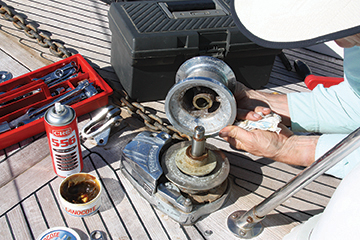
Clean and inspect your anchor chain and anchors for rust. If the chain is rusty, plan on regalvanizing it as soon as possible, as the chain will continue to rust and erode until it needs to be sandblasted or acid dipped and regalvanized.
Engine(s)
Lubricate throttle and shift linkage and cables. Check belts for wear and tension. Change engine and transmission oil and filter. Drain, flush and replace the coolant. Inspect and replace engine cooling system zinc anodes. Don’t let old antifreeze end up in the ocean, try to find a place that recycles or can properly dispose of it. Clean or replace the air cleaner. Flag anything that needs attention upon your return or by a mechanic while you’re away. Thoroughly clean the exterior of the engine. We use 409, paper towels and rags, followed by a stainless wire brush and touch-up paint. Place new oil absorbent sheets under the engine so that any oil or coolant leaks are easily detectable.
Don’t forget to service your outboard motor as well. Drain and replace lower unit gear oil and consider spraying fogging preservative down the engine intake before turning it off.
Batteries
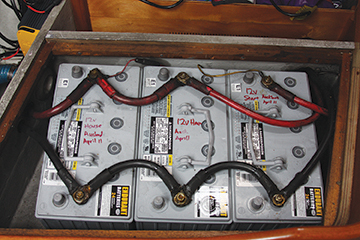 Check battery fluid levels if you don’t have gel or AGM batteries. Fully charge all batteries and then disconnect the master battery switch or remove the cables.
Check battery fluid levels if you don’t have gel or AGM batteries. Fully charge all batteries and then disconnect the master battery switch or remove the cables.
Interior
Launder all interior fabrics, as any salty, damp or dirty fabric will mildew. Clean galley cupboards and throw out or give away all food that will go stale or perish while you are gone. Go through all lockers and ask yourself, “Is this really necessary to have onboard?” Lighten that load instead of raising the bottom paint. Wipe all interior surfaces (excluding Plexiglas) with Windex. Leave out roach and ant bait and consider setting off a “bug bomb” just before leaving.
Life Raft
Note the expiration date of your life raft and inquire on the availability of repack facilities. If needed, schedule the repack after your return. When your raft gets serviced it will be inflated, so ask if you can be present to watch this, as it is always an interesting and educational experience.
Medical
Check your medical kit and take note of expiration dates on all drugs and items that need replenishing. Check local prices and availability, it may be easier and more cost effective to purchase supplies when returning home.
Rigging
Go up the mast to perform a thorough rig check of all fittings, welds, spreaders, lights, halyards, cotter pins, turnbuckles, sheaves, swages and wires. Lubricate the upper furling swivel, track and masthead sheaves. Clean and grease all your winches and turnbuckles. You may even consider pulling the mast if it needs repair or rigging replacement. If there are repairs that you’ll need help with, hire a rigger and book the necessary repair work before leaving.
Sails
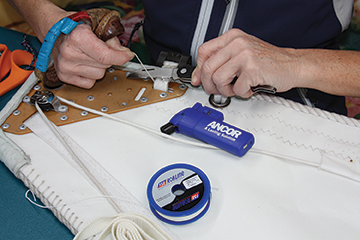 Remove all sails, including furling sails, wash, dry, inspect and fold them. If repairs are needed, find a sailmaker and book a time to have the repairs done before leaving your boat. If you are repairing the sails yourself, check that you have the necessary equipment and supplies.
Remove all sails, including furling sails, wash, dry, inspect and fold them. If repairs are needed, find a sailmaker and book a time to have the repairs done before leaving your boat. If you are repairing the sails yourself, check that you have the necessary equipment and supplies.
Systems
Flush the bilge with freshwater after collecting any oil by suspending oil absorbent material into the bilge. Fill propane tanks and disconnect all hoses. If your refrigeration system is raw water cooled, flush the system with fresh water. Biocide the watermaker. Remove and clean impeller for the knotmeter.
Tanks
Fill the fuel tanks and add bactericide. Flush holding tanks with water and add vinegar to break down scale. Lubricate all ball valves or seacocks. Flush freshwater tanks and bleach the tank and hoses.
Valuables
Find a secure storage place for electronics and valuables if necessary.
Before Hauling Out
Show the lift operator a photo or diagram of your boat’s underbody, marking ideal strap placement locations with masking tape. Request the most secure location in the storage area for your boat. The ideal location will be out of the regular traffic pattern of the Travelift and will be protected from strong winds from any direction. Several tropical boatyards have recently had boats blown over in strong winds. This is not good!
After Hauling

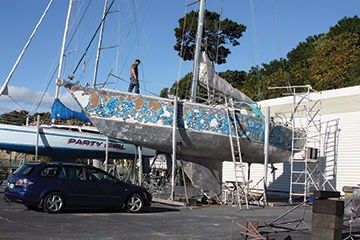 Have the boat pressure washed, if available, or clean off any growth by hand. Flush the engine for at least 20 minutes by disconnecting the raw water intake hose from the through-hull and placing it in a large bucket with a fresh water hose. It will take some adjusting to get the freshwater flow to match the engine intake requirement. In the last few minutes before shutting off the engine pour two to four quarts of coolant (antifreeze) into the bucket and shut off the engine before the last of the fluid is gone. If possible, have the exhaust flow into a bucket below the boat, as antifreeze should be disposed of correctly. If your boat will be left in freezing conditions, refer to the engine manual, it may recommend draining the freshwater cooling system and raw water cooling circuit. Dismantle and clean the vacuum valve if you have one.
Have the boat pressure washed, if available, or clean off any growth by hand. Flush the engine for at least 20 minutes by disconnecting the raw water intake hose from the through-hull and placing it in a large bucket with a fresh water hose. It will take some adjusting to get the freshwater flow to match the engine intake requirement. In the last few minutes before shutting off the engine pour two to four quarts of coolant (antifreeze) into the bucket and shut off the engine before the last of the fluid is gone. If possible, have the exhaust flow into a bucket below the boat, as antifreeze should be disposed of correctly. If your boat will be left in freezing conditions, refer to the engine manual, it may recommend draining the freshwater cooling system and raw water cooling circuit. Dismantle and clean the vacuum valve if you have one.
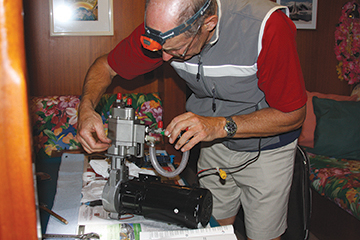
At a minimum, turn each handle and spray lubricant where the handle meets the fitting. If your boat is over 10 years old, consider replacing at least the head, galley and engine intake through-hulls and valves and all related plumbing. Replace any through-hull that is corroded.
Cover the Boat
A full boat cover protects your boat from sun, dirt and overspray, and will keep it cooler inside. Our cover was made in three sections that easily stows in duffel bags.
Record Stowage
Before leaving, photograph everything for insurance purposes: cradle or marina slip, cover, interior and position of the boat in the yard. Send your insurance company a note and a copy of the photographs and advise them of your plans.
RECOMMISIONING
Upon your return
Apply a fresh coat or two of antifouling paint and replace the zincs. Wax and polish the topsides. Inspect and possibly remove the rudder. Grease the rudder bearing and stern gland, if applicable. Check cables and gear on the steering system and quadrant. Look for cables that are too loose or have broken strands. Cables that are too tight will make a boat difficult to steer. Polish the propeller. If you have a feathering or folding prop, grease it. Reinstall raw water pump impeller. Reconnect and tighten battery cables and connections and cover them with Lanocote or similar waterproof grease. Connect the ground wire after the positive wire making sure all possible DC loads and battery charger are turned off. Test run the engine with the intake hose in a bucket before launching.
After Launching
Check through-hulls and hose clamps, the bilge for leaks. Scrub the decks and clean and wax the cabin sides and cockpit.
Systems
Check the anchor windlass operation and visually inspect the motor and electrical connections if possible. Replace the lubricating oil if necessary and remove, clean and grease the clutch/brake assembly. Reinstall knot log impeller. Flush and fill water tanks.
Rigging
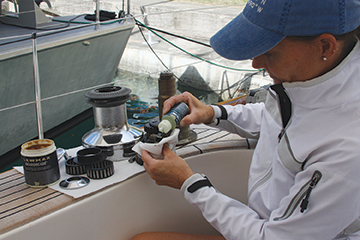 Go up the mast to perform a thorough rig check of all fittings and welds, spreaders, lights, halyards, cotter pins, turnbuckles, sheaves, swages and wires. Lubricate the upper furling swivel, track and masthead sheaves. If you are capable, tune the rig. If you’re not an expert, consider hiring a rigger to go for a quick tune-up and sail with you. Clean and grease winches if you didn’t do this before leaving your boat. Inspect all the running rigging and make replacements where needed.
Go up the mast to perform a thorough rig check of all fittings and welds, spreaders, lights, halyards, cotter pins, turnbuckles, sheaves, swages and wires. Lubricate the upper furling swivel, track and masthead sheaves. If you are capable, tune the rig. If you’re not an expert, consider hiring a rigger to go for a quick tune-up and sail with you. Clean and grease winches if you didn’t do this before leaving your boat. Inspect all the running rigging and make replacements where needed.
Sails
Bend on sails.
Safety Equipment
Service fire extinguishers, any MOB gear and PFDs. Have the life raft repacked if needed. Replace any expired flares and check your EPIRB’s operation and replace the battery. Check your medical kit and restock it with the supplies that you purchased while away.
Interior
Steam clean the carpets and all the cushions. Provision the galley.
Annual Engine Maintenance
Adjust valves. Tighten head bolts, if required. Align engine only after boat is back in the water and mast is tuned. Check the tension of all belts, particularly on alternators as any slippage causes overheating and burnout. Check turbo boost pressure, if applicable. Service fuel injectors, based on exhaust smoke. Check all charging systems. Rebuild starter motor and alternator every seven years or 5,000 hours. Purchase a one year supply of filters, impellers, belts and engine oil. If you’re not too mechanically inclined, consider hiring a diesel engine mechanic for a few hours to help you with the above list. If possible, try to find a mechanic that specializes in your make of engine.
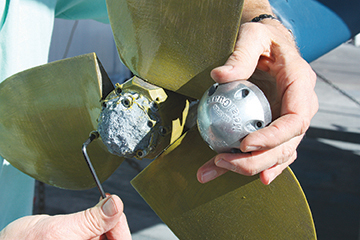
Sail Away
Before departing on your next ocean passage, plan for a short trip away on the boat. Once the boat is in the water and ship shape, spend a few days cruising to a few local, quiet spots. This will allow you to recover from the stress, grime and noise of yard work, and to check that all systems are operational.

















